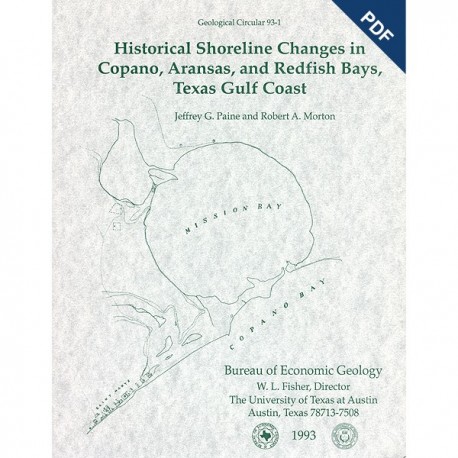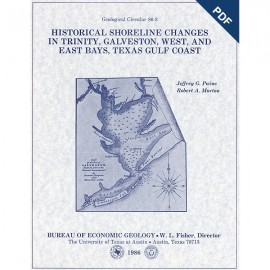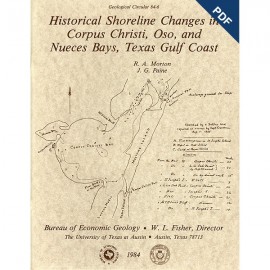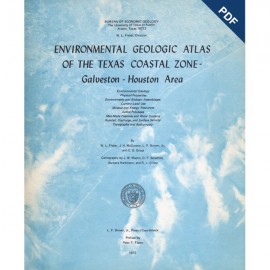Geological Circulars
-
Books & Reports
- Reports of Investigations
- Guidebooks
- Udden Series
- Geological Circulars
- Down To Earth
- Atlases of Major Oil and Gas Reservoirs
- Texas Memorial Museum Publications
- Environmental Geologic Atlas of the Texas Coastal Zone
- Mineral Resource Circulars
- Other Reports
- Seminars and Workshops
- Handbooks
- Submerged Lands of Texas
- Symposia
- Annual Reports
- Open File Reports
-
Maps & Cross Sections
- Thematic Maps
- Miscellaneous Maps, Charts & Sections
- Geologic Atlas of Texas
- STATEMAP Project Maps
- Geologic Quadrangle Maps
- Cross Sections
- Highway Geology Map
- Energy and Mineral Resource Maps
- Shoreline Change and Other Posters
- Wilcox Group, East Texas, Geological / Hydrological Folios
- Bouguer Gravity Atlas of Texas
- River Basin Regional Studies
- Featured Maps
- Posters
- Teachers & the Public
-
Geological Society Publications
- Gulf Coast Association of Geological Societies
- Alabama Geological Society
- Austin Geological Society
- Corpus Christi Geological Society
- Houston Geological Society
- Lafayette Geological Society
- Mississippi Geological Society
- New Orleans Geological Society
- South Texas Geological Society
- GCS SEPM Publications
- Historic BEG & UT Series

Historical Shoreline Changes in ... Bays, Texas Gulf Coast. Digital Download
GC9301D
For a print version: GC9301.
GC9301D. Historical Shoreline Changes in Copano, Aransas, and Redfish Bays, Texas Gulf Coast, by J. G. Paine and R. A. Morton. 66 p., 30 figs., 5 tables, 3 appendices, 1993. doi.org/10.23867/gc9301D. Downloadable PDF.
To purchase this publication in book format, please order GC9301.
ABSTRACT
Shorelines bordering the bays of Texas are generally not as dynamic as those along the Gulf of Mexico. Nevertheless, the predominantly erosional movement of these bay shorelines translates to large losses of wetlands, arable uplands, and recreational and residential property. The shorelines occur along steep clay bluffs, along salt- and brackish water marshes, along sand and shell beaches, at the base of moderate slopes composed mainly of sand, and in newly formed areas filled by dredged material. Unprotected sediments forming the margins of these bays are modified by natural coastal processes and human activities, both of which can cause shoreline movement. This study of historical shoreline movement in the Copano Bay system (1) quantifies bay shoreline movement since 1930, (2) describes shoreline types around Copano Bay and coastal processes affecting shoreline position, and (3) relates spatial and temporal differences in rates of shoreline movement to changes in coastal processes in different settings and at different times.
Changes in shoreline position along Texas bays over several decades permit estimation of the relative stability of these shorelines; these changes also allow comparisons of recent shoreline movement with that which occurred when the bay system was less affected by human modification. Documenting long-term movement along the 233 mi of shoreline surrounding the Copano Bay system (Copano, Aransas, Redfish, Mission, Port, and St. Charles Bays) included comparing three sets of aerial photographs taken in the early 1930's - late 1950’s, and 1982, measuring shoreline movement, calculating rates of change, and summarizing in tables and on maps the magnitudes and rates of shoreline change.
Despite widespread use of shoreline protection measures, which began in some areas before 1930, shorelines within the Copano Bay system largely retreated between the early 1930's and 1982. During this period, bay shorelines moved landward an average of 0.8 ft/yr, resulting in loss of about 23 acres of land per year. Rates of land loss for the most recent monitoring period (late 1950's to 1982) were even higher, reaching an average of 2.5 ft/yr, or about 71 acres/yr when averaged over the entire bay system.
Shoreline attributes (orientation, wave fetch, and sediment type) determine shoreline response to coastal processes. Contributing to shoreline changes are (1) frequent and intense storms, (2) local changes in relative sea level, (3) human activities, (4) local alterations in sediment supply, and (5) regional and worldwide climate. The increased shoreline retreat during the more recent period can be attributed to natural and human-induced factors, including an increase in major hurricanes, low bay water levels during the drought of the 1950’s, higher rates of sea-level rise, increased coastal development and compartmentalization, and lower fluvial sediment influx. Historical data indicate that recurring severe storms, rising sea level, ongoing human activities, decreasing sediment supply, and increasing temperatures will lead to continued erosion of most shorelines in the Copano Bay system.
Keywords: Aransas Bay, bays, Copano Bay, Redfish Bay, shoreline changes, shoreline erosion, shoreline protection, Texas Coastal Zone, Texas
Citation
Paine, J. G., and Morton, R. A., 1993, Historical Shoreline Changes in Copano, Aransas, and Redfish Bays, Texas Gulf Coast: The University of Texas at Austin, Bureau of Economic Geology, Geological Circular 93-1, 66 p. doi.org/10.23867/gc9301D.




